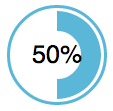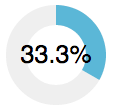A very simple (responsive) circular chart/dial using Raphäel.
To use, include Raphäel, then pass an element with a number in it to the constructor. What you do with the CSS is up to you.
To give an example, you might do something like the following:
<!doctype html>
<html lang="en">
<head>
<meta charset="UTF-8">
<title>Circle Chart</title>
<style>
.circle-chart { width: 25%; position: relative; }
.circle-chart__text { position: absolute; width: 100%; height: 100%; text-align: center; left: 0; top: 0; line-height: 4; font-family: sans-serif; }
</style>
</head>
<body>
<!-- Number goes inside a HTML element -->
<div class="circle-chart">
85%
</div>
<!-- Load the required libraries -->
<script src="//cdnjs.cloudflare.com/ajax/libs/raphael/2.1.2/raphael-min.js"></script>
<script src="js/circle-chart.js"></script>
<!-- Create the chart -->
<script>
var el = document.querySelector('.circle-chart');
new CircleChart(el);
</script>
</body>
</html>You can pass an options object as a second parameter to the constructor. The defaults are something like the following:
{
stroke: 20, // Width of the circle (in pixels)
maxVal: 100, // Maximum value for the chart
colour: '#56b7d6', // Colour of the circle (yes, with British spelling)
animationSpeed: 1000, // Time in ms for animations,
edgeWidth: 0, // Width of the border (zero means no border)
edgeGap: undefined, // Gap between border and chart. Defaults to edgeWidth.
edgeColour: '#56b7d6', // Colour of the border.
trackColour: 'transparent', // Colour of the track beneath the chart.
edgeClass: 'edge', // class name for the edge
trackClass: 'track', // class name for the track
pathClass: 'path', // class name for the path
pathEasing: 'ease-in-out' // follows the naming convention of Raphael.easing_formulas
}Released under the MIT License.


